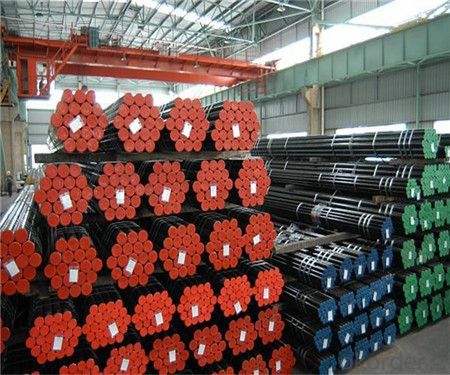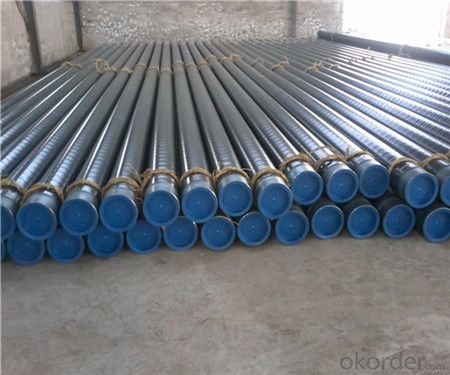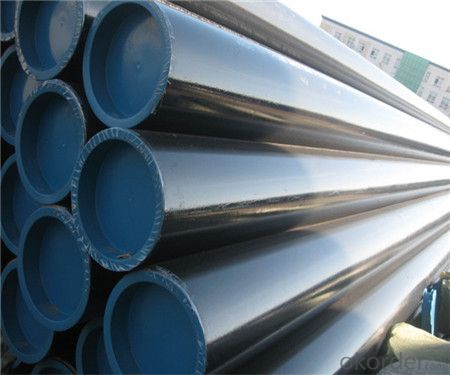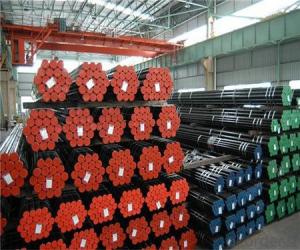China Seamless Steel Pipe/Tube Line Pipe API SPEC 5L Factory
- Loading Port:
- Tianjin
- Payment Terms:
- TT OR LC
- Min Order Qty:
- 20 m.t.
- Supply Capability:
- 12000 m.t./month
OKorder Service Pledge
OKorder Financial Service
You Might Also Like
Product Description:
▲ Line pipe
▲ Tubing and casing
▲ L & M & H boiler tube
▲ Gas cylinder tube & pipe
▲ Mechanical & Structural pipe
▲ Ship-building tube & pipe
▲ Automobile tube & pipe
LINE PIPE
Standard: API SPEC 5L
● Application: To be used for conveying gas, water, and
petroleum for oil and natural gas industries
2、Main Features of the Seamless Pipe :
• High manufacturing accuracy
• The higher strength
• The small inertia resistance
• Strong heat dissipation ability
• Good visual effect
• Satisfy price
3、Seamless Pipe ASTM DIN1829 Specification:
Standard | GB, DIN, ASTM ASTM A106-2006, ASTM A53-2007 |
Grade | 10#-45#, 16Mn 10#, 20#, 45#, 16Mn |
Thickness | 8 - 33 mm |
Section Shape | Round |
Outer Diameter | 133 - 219 mm |
Place of Origin | Shandong, China (Mainland) |
Secondary Or Not | Non-secondary |
Application | Hydraulic Pipe |
Technique | Cold Drawn |
Certification | API |
Surface Treatment | factory state or painted black |
Special Pipe | API Pipe |
Alloy Or Not | Non-alloy |
Length | 5-12M |
Outer Diameter | 21.3-610mm |
Grade | 20#, 45#, Q345, API J55, API K55, API L80, API N80, API P110, A53B |
Standard | ASME, ASTM |
1) Material:20#(ASTM A 106/A53 GRB.API5LGRB,GB),45#,16Mn,10#.
2) Specification range:OD:21.3-610mm,WT:6-70mm,length:6-12m or according to the requirement of clients.
3) Excutive standards:GB,ASME API5L.ASTM A 106/A53,Despite of the above standards,we can also supply seamless steel pipe with standard of DIN,JIS,and so on,and also develop new products according to the requirements of our clients!
4) Surface:black lacquered,varnish coating or galvanized.
5) Ends:Beveled or square cut,plastic capped,painted.
6) Packing:bundles wrapped with strong steel strip,seaworthy packing.
4、Packaging & Delivery
Packaging Details: | seaworthy package,bundles wrapped with strong steel strip |
Delivery Detail: | 15-30days after received 30%TT |
5、FAQ of Seamless Pipe ASTM DIN1829:
①How is the quality of your products?
We have many years business experience in this area, and we have professional engineer and manager team and sure we can provide you high quality production and professional service.
②How about price?
Yes, we are factory and be able to give you lowest price below market one, and we have a policy that “ for saving time and absolutely honest business attitude, we quote as lowest as possible for any customer, and discount can be given according to quantity”,if you like bargain and factory price is not low enough as you think, just don’t waste your time.Please trust the quotation we would give you, it is professional one.
③Why should you chose us?
We can give you both.Additionally, we can also offer professional products inquiry, products knowledge train(for agents), smooth goods delivery, exellent customer solution proposals.Our service formula: good quality+good price+good service=customer’s trust
SGS test is available, customer inspection before shipping is welcome, third party inspection is no problem
our advantage:
Professional teams ensure a high efficiency of your purchase
▲ Professional sales team
▲ Professional engineering and technology team
▲ Professional exportation and contract processing/management team
▲ Professional cooperators and partners
6、Seamless Pipe Images:



- Q:Can galvanized pipe be welded with seamless steel tube? What should I do to connect?
- See the galvanized pipe and seamless steel pipe steel that differences in how if the difference is too large then the steel used for two kinds of materials for welding requirements is not the same, do not recommend direct welding, low pressure can be used in high voltage wire, welding on both sides of the same material flange with flange connection.
- Q:Can steel pipes be used for LNG terminals?
- Yes, steel pipes can be used for LNG terminals. Steel pipes are commonly used in LNG terminals for transporting and distributing liquefied natural gas due to their strength, durability, and ability to withstand extreme temperatures and pressures. Additionally, steel pipes can be easily welded and have excellent corrosion resistance, making them suitable for the transportation and storage of LNG.
- Q:What are the common methods for repairing steel pipes?
- There are several common methods for repairing steel pipes, depending on the nature and extent of the damage. One common method is welding, which involves melting the damaged area and fusing it with a new piece of steel. This method is often used for small cracks or holes in the pipe. Welding can be done using various techniques such as shielded metal arc welding (SMAW), gas metal arc welding (GMAW), or tungsten inert gas (TIG) welding. Another method is pipe wrapping or bandaging, which involves wrapping a layer of adhesive tape or resin-soaked fiberglass around the damaged section of the pipe. This method is suitable for small leaks or corrosion spots and provides a temporary fix until a more permanent solution can be implemented. If the damage is extensive or the pipe is severely corroded, pipe lining or relining may be necessary. This involves inserting a new pipe liner inside the existing one, effectively creating a new pipe within the old one. This method can be done using various materials such as epoxy, polyethylene, or cured-in-place pipe (CIPP). Pipe lining is commonly used for larger diameter pipes or when replacement is not feasible. In some cases, pipe clamps or sleeves can be employed to repair minor leaks or cracks. These devices are designed to be clamped around the damaged section and provide a temporary or permanent solution depending on the severity of the damage. Ultimately, the choice of repair method depends on factors such as the extent of damage, accessibility of the damaged area, budget constraints, and the long-term durability required. It is advisable to consult with a professional pipe repair specialist to assess the specific situation and determine the most suitable method for repairing steel pipes.
- Q:What is the impact toughness of steel pipes?
- The impact toughness of steel pipes refers to the ability of the material to withstand sudden or high-velocity impacts without fracturing or breaking. It is a measure of the material's resistance to cracking under dynamic loading conditions. The impact toughness of steel pipes is an important property as it determines their ability to withstand accidental impacts or external forces during transportation, installation, and operation. The impact toughness of steel pipes is typically evaluated using standardized tests such as the Charpy V-notch test or the Izod test. These tests involve striking a notched sample of the steel pipe with a pendulum or a falling weight and measuring the energy absorbed by the material before it fractures. The impact toughness is then calculated based on this energy absorption. A high impact toughness is desirable in steel pipes as it indicates a greater ability to absorb energy and resist fracture, making them more resistant to sudden impacts or loading conditions. This is particularly important in applications where steel pipes are used in high-stress environments, such as in oil and gas pipelines, automotive components, or structural applications. Various factors can affect the impact toughness of steel pipes, including the chemical composition, heat treatment, and microstructure of the steel. For example, alloying elements like manganese, chromium, and nickel can enhance the impact toughness by promoting the formation of fine-grained microstructures and preventing the propagation of cracks. Similarly, proper heat treatment processes such as quenching and tempering can improve the impact toughness by optimizing the material's microstructure and mechanical properties. In summary, the impact toughness of steel pipes is a crucial property that determines their ability to withstand sudden or high-velocity impacts. It is evaluated through standardized tests and is influenced by factors like chemical composition, heat treatment, and microstructure. A high impact toughness is desirable in steel pipes to ensure their structural integrity and resistance to fracture under dynamic loading conditions.
- Q:What are the environmental benefits of using steel pipes?
- Using steel pipes has multiple environmental benefits: 1. Longevity: Steel pipes have a prolonged lifespan, minimizing the need for frequent replacements. This conserves resources and reduces waste generation. 2. Recyclability: Steel is extensively recycled worldwide. When steel pipes reach the end of their life, they can be easily recycled and used to produce new steel products. This reduces the demand for raw materials and saves energy that would otherwise be necessary for manufacturing new materials. 3. Decreased carbon emissions: Steel pipes have a lower carbon footprint compared to materials like concrete or plastic. The manufacturing process emits fewer greenhouse gases, contributing to an overall lower carbon footprint. 4. Corrosion resistance: Steel pipes exhibit high resistance to corrosion, requiring less maintenance and repair compared to other materials. This reduces the need for chemical coatings and treatments that can have detrimental environmental effects. 5. Water conservation: Steel pipes are commonly used in water supply and distribution systems. Their smooth interiors minimize friction, reducing the energy required to pump water through the pipes. This conserves energy and decreases carbon emissions associated with water transportation. 6. Fire resistance: Steel pipes are inherently fire-resistant, making them a safer choice for various applications. In the event of a fire, steel pipes help contain the spread of flames and minimize environmental damage. In summary, the use of steel pipes provides numerous environmental benefits, including durability, recyclability, reduced carbon emissions, water conservation, and fire resistance. These factors make steel pipes a sustainable option for various infrastructure projects.
- Q:What are the different types of fittings used with steel pipes?
- Steel pipes are commonly paired with various fittings that serve to connect, control, or alter the flow direction in a piping system. Some of these fittings include: 1. Elbow fittings: Designed to modify the flow direction, elbow fittings are available in different angles, such as 45 or 90 degrees. They are frequently utilized to navigate obstacles or introduce bends in the pipe. 2. Tee fittings: Tee fittings are implemented to create a branch or division in the piping system. With three openings, one perpendicular to the other two, they enable the connection of two pipes at a 90-degree angle. 3. Coupling fittings: Used to join two pipes of the same size, coupling fittings are typically threaded and can be easily fastened or removed with a wrench. They are commonly employed when pipes need to be connected or repaired. 4. Reducer fittings: Reducers are employed to connect pipes of varying sizes. They consist of one end with a larger diameter and another end with a smaller diameter. Reducers are often employed to transition between pipe sizes or adapt to different equipment or fittings. 5. Flange fittings: Flanges are utilized to establish a secure and leak-proof connection between pipes, valves, or other equipment. They consist of a flat, circular plate with holes to accommodate bolts or screws for fastening the flange to the pipe. Flange fittings find frequent use in applications that necessitate frequent disassembly and reassembly. 6. Union fittings: Union fittings are employed to join two pipes in a manner that facilitates easy disconnection. They comprise three parts: a nut, a female end, and a male end. Union fittings are commonly used in scenarios that require periodic maintenance or repairs. 7. Cap fittings: Cap fittings are employed to seal the end of a pipe. Usually threaded, they can be effortlessly screwed onto the pipe's end. Cap fittings are commonly used in instances where temporary closure or protection of pipes is necessary. These examples represent some of the various fittings utilized with steel pipes. The specific fitting required depends on factors such as the application, pipe size and material, as well as the desired functionality of the piping system.
- Q:How are steel pipes inspected for defects?
- Steel pipes are typically inspected for defects using various non-destructive testing methods such as ultrasonic testing, magnetic particle inspection, and visual inspection. These techniques help identify any cracks, corrosion, or other defects in the pipes, ensuring their structural integrity and quality.
- Q:How are steel pipes used in HVAC systems?
- Steel pipes are commonly used in HVAC systems for transporting hot or cold water, as well as other fluids like refrigerants and condensate. They are durable, resistant to corrosion, and can withstand high pressure, making them ideal for carrying fluids throughout the system. Steel pipes are typically used for water supply lines, steam distribution, and hydronic heating and cooling systems in HVAC installations.
- Q:Can steel pipes be bent or shaped?
- Yes, steel pipes can be bent or shaped using various methods such as cold bending, hot bending, or using hydraulic or mechanical equipment.
- Q:How are steel pipes used in the defense sector?
- Steel pipes are used in the defense sector for various purposes such as constructing military infrastructure, manufacturing weapons, and creating protective barriers. They are often utilized in the construction of military bases, ammunition storage facilities, and communication systems. Steel pipes are also crucial for manufacturing armored vehicles, artillery, and missile systems. Additionally, they are employed in creating barriers and fortifications to enhance security and defense capabilities.
1. Manufacturer Overview |
|
|---|---|
| Location | |
| Year Established | |
| Annual Output Value | |
| Main Markets | |
| Company Certifications | |
2. Manufacturer Certificates |
|
|---|---|
| a) Certification Name | |
| Range | |
| Reference | |
| Validity Period | |
3. Manufacturer Capability |
|
|---|---|
| a)Trade Capacity | |
| Nearest Port | |
| Export Percentage | |
| No.of Employees in Trade Department | |
| Language Spoken: | |
| b)Factory Information | |
| Factory Size: | |
| No. of Production Lines | |
| Contract Manufacturing | |
| Product Price Range | |
Send your message to us
China Seamless Steel Pipe/Tube Line Pipe API SPEC 5L Factory
- Loading Port:
- Tianjin
- Payment Terms:
- TT OR LC
- Min Order Qty:
- 20 m.t.
- Supply Capability:
- 12000 m.t./month
OKorder Service Pledge
OKorder Financial Service
Similar products
New products
Hot products
Related keywords






























